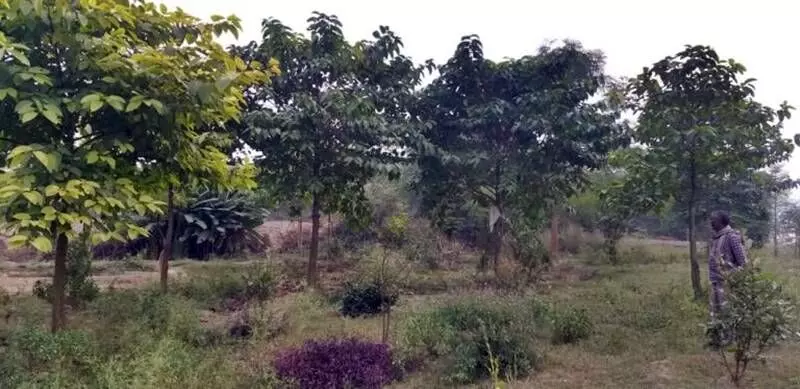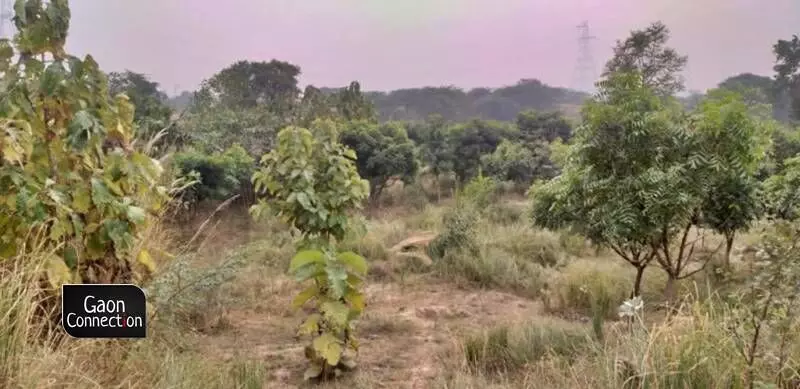The commitment to serve the nation amongst some bureaucrats is such that their efforts not only benefit the public but also leave a mark on the flourishing flora and fauna of the region. One such feat is achieved by Neha Sharma, an officer from the Indian Administrative Service (IAS) who is presently posted as State Mission Director of Swachh Bharat Mission (Urban) and Director of Local Bodies in Uttar Pradesh.
Sharma’s conservationist efforts in Firozabad district have transformed a plot of barren land into a micro forest. The efforts which began in 2017, also involved the contribution of the rural residents in the area.
Between Firozabad and Agra districts, on both sides of the Lucknow-Agra Expressway, there are many deep ravines, mud island structures, and barren wastelands. They are bone-dry and devoid of vegetation and are infested with termite. The proportion of calcium pebbles in the soil is also very high. Farming in these lands is next to impossible and villagers go through great pains to cultivate their crops in the nearby areas.
The initiative to rejuvenate these plots of barren lands was taken up by Neha Sharma who back then was the District Magistrate of Firozabad. For the initiative a plot of land spreading over an acre of land was selected near the Yamuna river bank in the Jalalpur village.
Sharma formed a team of officers, village council headman (pradhan), village panchayat secretary, and some local villagers.
Local community support vital in afforestation campaign
Rambabu, a local villager was entrusted with overseeing the initiative, and his primary responsibility was to take care of the saplings planted which was a major contribution in the success of the project.
Rambabu told me that taking care of saplings and growing them in a jungle was an arduous task. Usually, post-plantation saplings do not achieve successful growth due to lack of moisture, poor soil fertility, and lack of ground level monitoring.

Rambabu also prevented infestation of termites by using a mixture of turmeric powder and sugar at the base of plants, and sprayed a mixture of neem leaves on saplings. He also used cow dung to increase the humus content in the soil. Such was his dedication that he took out calcium pebbles from the soil.
The IAS officer provided ground support and other facilities to Rambabu through village council which was vital for successful growth of the plants. Due to dedicated efforts of Sharma, Rambabu, villagers, and the village council, this project became a success.
Now, plants have become lush green trees, and biodiversity in the area is spreading out to nearby barren lands. The trees have become home to diverse species of birds as well as squirrels.
The swarms of Butterflies and honeybees also frequent this place and the entire plot of land is unrecognisable from its earlier condition.
Ravindra Singh Gurjar of Jalalpur village reports that he has put the earthen pots filled with water below the trees for birds, squirrels, and other creatures.
Vijay Tenguriya, branch manager of a local bank says that this jungle has become a boon for the villagers. District Magistrate Sharma has now been transferred but villagers are maintaining the greenery of the jungle. More than 90 per cent of the planted saplings are thriving as trees.

Now, plants have become lush green trees, and biodiversity in the area is spreading out to nearby barren lands. The trees have become home to diverse species of birds as well as squirrels.
Since the last five years, a saint named Pagal Das Baba and his followers have been living in this forest area. These saints also take care of trees. The saint says that the small trees and vines are the ornaments of the Earth, and big trees maintain the balance in Nature.
“Nature is a form of God; God lives in Nature. We all should understand and respect this relationship because Nature has no gardener and no one is its painter. Nobody has seen God but one can feel about God by looking at Nature. So serve Nature because God lives in Nature. He further says that District Magistrate’s efforts are providing an ecosystem of life for all the living beings of the area. Villagers and we saints are thankful to her,” the saint says.
Trees are not only the source of oxygen, food, fodder, medicine, wood, fruits, flowers, seeds, shelter, and absorb greenhouse gases like carbon dioxide but also emit volatile organic compounds (VOCs). These VOCs are important for the health of all living beings and are able to boost immunity and save lives from any kind of infection.
Trees found to offer protection against COVID-19 & earthquakes
A study on lower COVID-19 mortality in Italy’s forested areas authored by Valentina Roviello and Giovanni N. Roviello published in Environmental Chemistry Letters on February 14, 2021 explains a surprising role of protection offered by trees in the Mediterranean region.
In southern Italy, the Mediterranean trees played a protective role and were found to have reduced the incidence of COVID-19 cases. It was found that the pandemic’s severity was lower in southern Italy, especially those with more than 0.3 hectares of forest per capita. In South Italy, the forests mitigated air pollution by intercepting Particulate Matter (PM) particles onto plant surfaces and increased the human immune system by emitting VOCs.
Trees are also able to reduce the impact of earthquake waves. When an earthquake impacts a plant, the plant is capable of absorbing a large part of the energy because plant cells have the capacity to slide over one another. So, planting trees in particular places around buildings could scatter the seismic waves which would lessen the impact of an earthquake. Trees offer local protection against an earthquake’s surface waves of certain frequencies.

The swarms of Butterflies and honeybees also frequent this place and the entire plot of land is unrecognisable from its earlier condition.
“All of us should keep trying so that this world can be saved from the adverse effects of anthropogenic climate change. We all should work for Nature and Mother Earth so that the world can be made livable for the future generations,” Sharma remarked.
Earth is warming because anthropogenic activities have changed the earth’s climate. We have entered a new era, the Anthropocene. The fifth assessment report of the Intergovernmental Panel on Climate Change (IPCC) concluded that climate change would lead to large scale human migration, conflicts for water, land and food, and challenges for security equilibrium across the globe. Only, climate action at grassroot like we see in Firozabad will solve the ongoing climate crisis.
Climate change will adversely change global tree coverage. If we do not take concrete steps at the grassroots level, by 2050 the global tree canopy could be reduced by about 223 million hectares.
The author is the founder of Red Tape Movement which works for preventing deforestation. Views are personal.


















